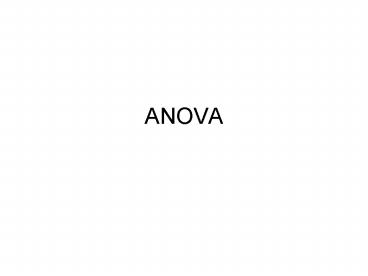ANOVA - PowerPoint PPT Presentation
Title:
ANOVA
Description:
ANOVA Conceptual Basics One variable (Interval / Ratio level DV) one group (No IV) surveyed once: One variable (Interval / Ratio level DV) two groups (One ... – PowerPoint PPT presentation
Number of Views:129
Avg rating:3.0/5.0
Title: ANOVA
1
ANOVA
2
Conceptual Basics
- One variable (Interval / Ratio level DV) one
group (No IV) surveyed once - One variable (Interval / Ratio level DV) two
groups (One categorical level IV with two groups
(also called factors)) each group surveyed
once - One variable (Interval / Ratio level DV only)
one group (No IV) surveyed twice - One variable (Interval / Ratio level DV) more
than two groups (One categorical level IV with
more than two groups (also called factors))
surveyed once
3
Conceptual Basics One Way ANOVA
- Each group (factor) in the sample may feel
differently about the dependent variable being
measured (recall stratified sampling???) - Within each group (factor), the members amongst
themselves may also feel somewhat differently
about the variable being measured - Objective of the ANOVA
4
Conceptual Basics One Way ANOVA
- Differences between groups sums of squares
between factors - D.f. are number of factors 1
- Ratio gives you Mean sums of squares for
numerator (MSS n) - Differences within groups sums of squares
within factors - D.f. are sample size number of factors
- Ratio gives you Mean sums of squares for the
denominator (MSS d) - Ratio of MSS n and MSS d gives you the observed
test statistic (the F ratio)
5
Conceptual Basics One Way ANOVA
- The Observed test statistic (F ratio)
6
Conceptual Basics One Way ANOVA
- The critical test statistic (critical F ratio)
- Becomes smaller as sample size increases but
larger as number of groups/factors increase - If observed F gt critical F, reject the Ho
- If observed F lt critical F, accept the Ho































